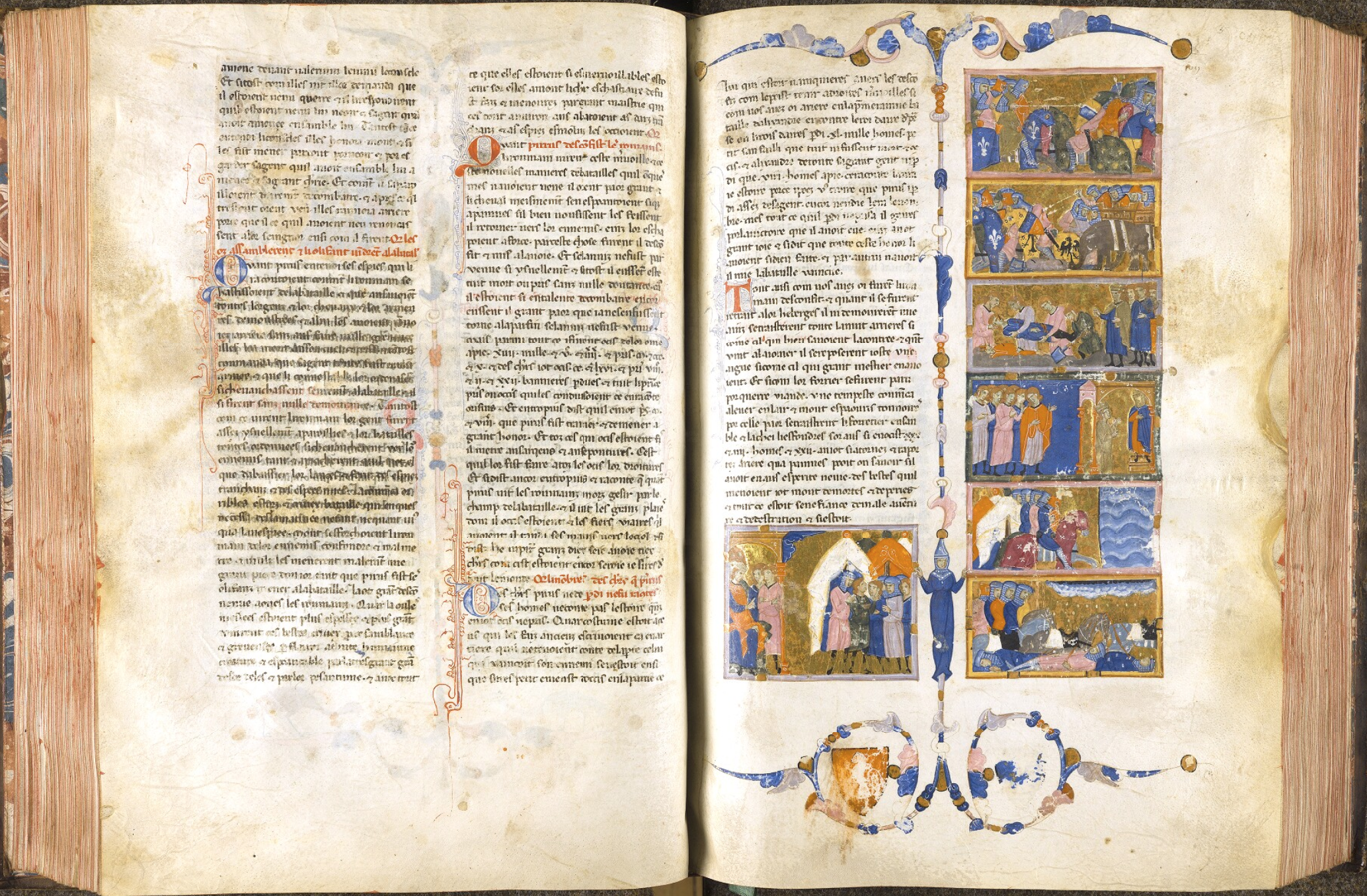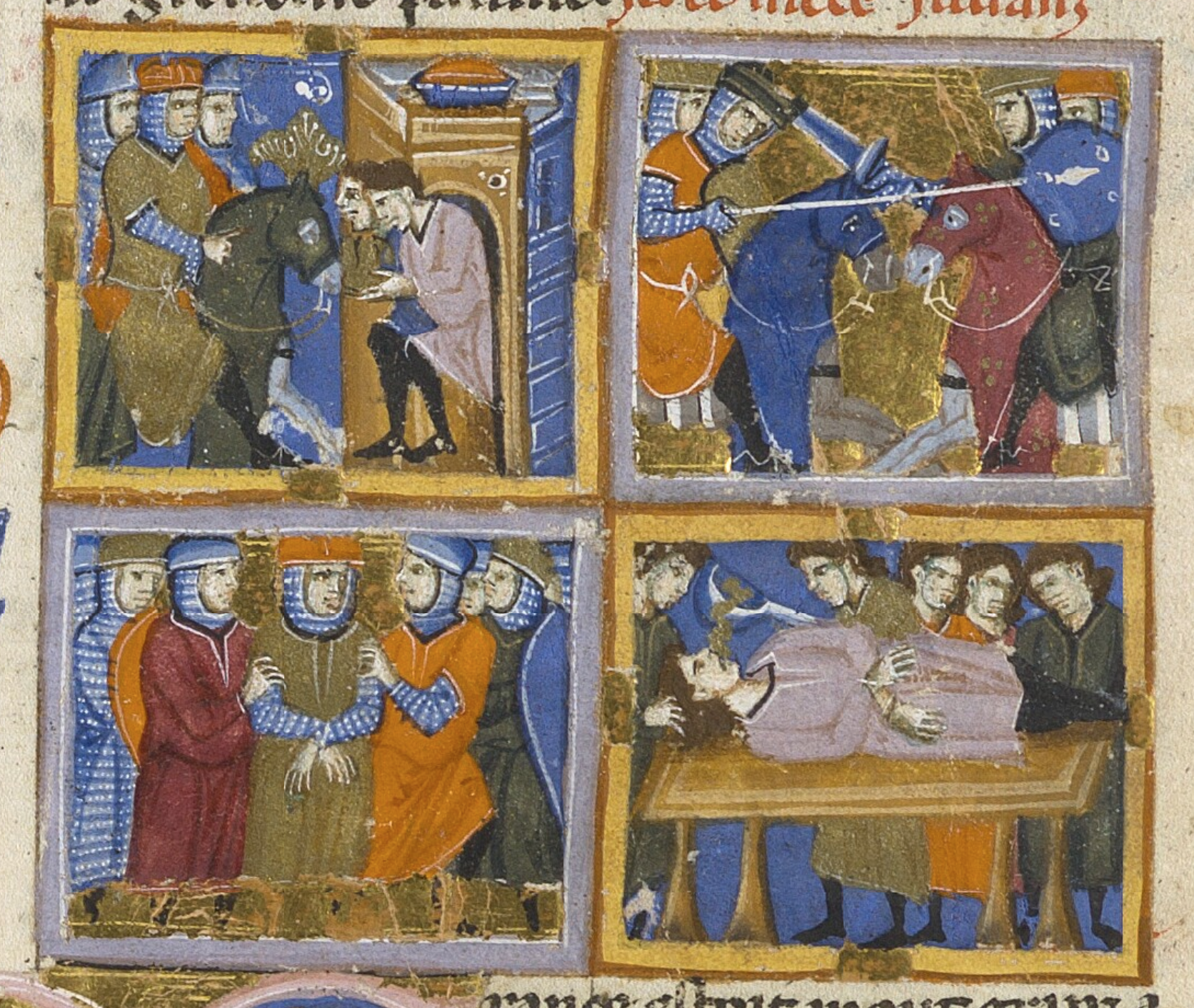Fit for a king? Aligning Chantilly, Bibliothèque du château, 726
One of the earliest and most important manuscripts of the Histoire ancienne jusqu'à César is now available to compare with other copies of the text using TVOF's Alignment tool. Chantilly, Bibliothèque du château, 726 is a lavishly illuminated manuscript produced in Italy during the second half of the thirteenth century. Ella Williams has recently argued that it was commissioned by Guy de Montfort (d. 1291), son of rebel baron Simon de Montfort (d. 1265), as a gift for king Charles I of Anjou (d. 1285). Chantilly 726's role in the dissemination of the Histoire ancienne in Italy has perhaps gone understated: it was at the same Angevin court that second-redaction manuscript Royal D 20 I would be produced under the reign of Charles's grandson, Robert of Anjou (d. 1343) [see Luca Barbieri's blog post].

Coats of arms of Guy de Montfort (left) and Charles I of Anjou (right). Chantilly, Bibliothèque du château, 726, f. 109r. Source: BVMM.
Chantilly 726 is significant also for the pairing of the Histoire ancienne with the Faits des Romains (ff. 175r–343v), an account mainly of Julius Caesar's life and deeds. These two texts are frequently transmitted together (in at least two dozen manuscripts), but Chantilly is the earliest surviving witness to do so. According to Doris Oltrogge, two artists are at work in Chantilly: one responsible for folios 1 to 107 (and f. 175), and the other for 108 to 334. This second artist has been compared to the ‘Maestro del 1285’ active in Bologna in this period. The illustrative cycle – characterised by multi-compartment illuminations divided into two registers, as well as an opening historiated ‘Q’ depicting the days of creation – is shared with a group of manuscripts produced in northern France (including British Library, Additional 19669, and BnF fr. 17177). Chantilly's use of four-compartment illuminations for the Faits (compare to BnF fr. 23082) demonstrates a partial decorative consistency across the two texts. Unfortunately, a number of folios likely to have contained images are missing from the first part of Chantilly (see Alignment for the placement of these lacunae).

Opening to the Rome II section, depicting events of the narrative in seven frames. Chantilly, Bibliothèque du château, 726, f. 109r. Source: BVMM.
In her blog post on the importance of Italian book illustration and design to the afterlives of the Histoire ancienne, Rosa María Rodríguez Porto shows how Chantilly and others refocused emphasis within the text away from biblical to profane history. If the second redaction (Royal D 20 I) radically re-centres Trojan history by removing Genesis and inserting a vast mise en prose of Benoît de Sainte-Maure's Roman de Troie (Prose 5), Chantilly foregrounds the Roman past as the focus of its aesthetic and ideological lens. This is clear on the one hand through the page introducing Rome II (almost at the point where artist two takes over), which in seven scenes depicts the coming events of the narrative, while the bas-de-page displays the Montfort and Angevin coats of arms. On the other, Alignment shows us that Chantilly retains a much higher number of paragraphs of the Rome II section, which is abridged to lesser or greater extents in British Library, Additional 19669 and BnF fr. 17177 respectively. Moreover, the manuscript plays down the transition between the Histoire ancienne and the Faits des Romains as no blank space is left between the two texts (f. 175r), and the rubric introducing the Faits is not made particularly prominent. A shift is more subtly signalled by a four-compartment illumination produced by artist one. Most interestingly, two paragraphs of the Histoire ancienne (§1236 and §1237) find themselves included further on in the Faits des Romains (ff. 187v–188r), coupled with an illumination of Crassus's execution found also in BnF fr. 17177 (and discussed in this blog post).
Research remains to be done on the place of Chantilly within its textual and iconographic traditions. A significant question mark also looms over when, how, and why the abridged version travelled from northern France to Italy. Nevertheless, it is hoped that Alignment will provide crucial support in piecing together a picture of the Histoire ancienne's embeddedness in aristocratic networks and its movement across time and space in the thirteenth century.
Henry Ravenhall
Bibliography
FLUTRE, Louis-Fernand, Les Manuscrits des Faits des Romains (Paris: Hachette, 1932).
OLTROGGE, Doris, Die Illustrationszyklen zur Histoire ancienne jusqu'à César (1250–1400) (Frankfurt and New York: Peter Lang, 1989), p. 39.
PERRICCIOLI SAGGESE, Alessandra, ‘Un codice bolognese alla corte angioina di Napoli: l’Histoire ancienne di Chantilly appartenuta a Guy de Montfort e il problema della Bibbia di Corradino’, in Napoli e Emilia: studi sulle relazioni sociali e artistiche, ed. by Andrea Zezza (Naples: Luciano Editore, 2010), pp. 19–30.
WILLIAMS, Ella, ‘Two Manuscripts of the Faits des Romains in Angevin Italy’, Italian Studies, 72 (2017), 157–76.
